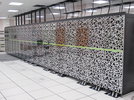SCIENCE
CURIE: the first large scale hybrid system available in PRACE
PRACE welcomes the expansion of the French Tier-0 system, CURIE, with a hybrid fraction.
Installed in France at the Très Grand Centre de Calcul (TGCC) operated by CEA near Paris, CURIE is the second PRACE Tier-0 system. Funded by GENCI, as the French representative in PRACE, designed and built by Bull, CURIE has general purpose modular architecture, based on a mix of thin and fat nodes.
During last summer, it was extended with a hybrid fraction. This upgrade was realised by adding 192 Teraflop/s (DP) peak performance provided by 288 nVIDIA M2090 GPUs fitted into 144 Bull B505 blades.
Altogether, this will lead CURIE to deliver a global peak performance of more than 1.7 Petaflop/s, by the end of this year.
CURIE is the first large scale hybrid system available into PRACE. “It is important for PRACE to extend its facilities with hybrid supercomputing resources. CURIE will be the first of a larger generation of hybrid systems in PRACE. With CURIE, European scientists will be able to exploit the potential of these novel system architectures”, expressed Dr. Maria Ramalho, PRACE Managing Director.
The whole hybrid fraction of CURIE will be opened to European researchers through the 4th PRACE Regular call, starting on November 1st, 2011. European researchers will be able to use it for adapting their applications to generate scientific results on hybrid production systems. This fraction will be entirely dedicated to the hands-on of the upcoming PRACE Autumn School on “Advanced Hybrid Programming”, held by GENCI and CEA from October 25th to 27th at TGCC.
More information about CURIE: http://www-hpc.cea.fr/en/complexe/t...
More information about PRACE Calls: www.prace-ri.eu/hpc-access

